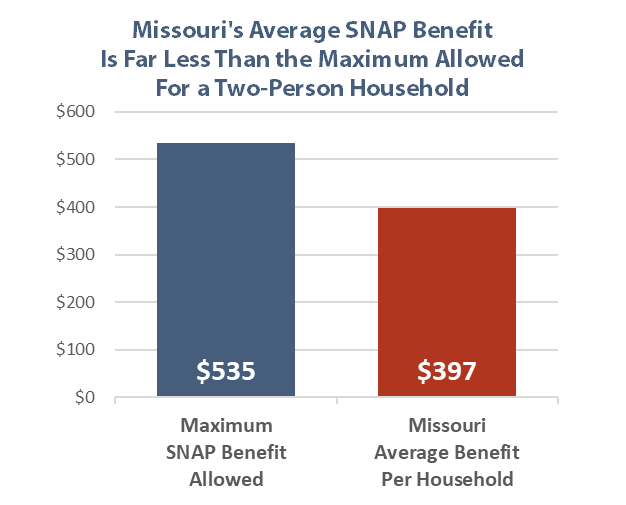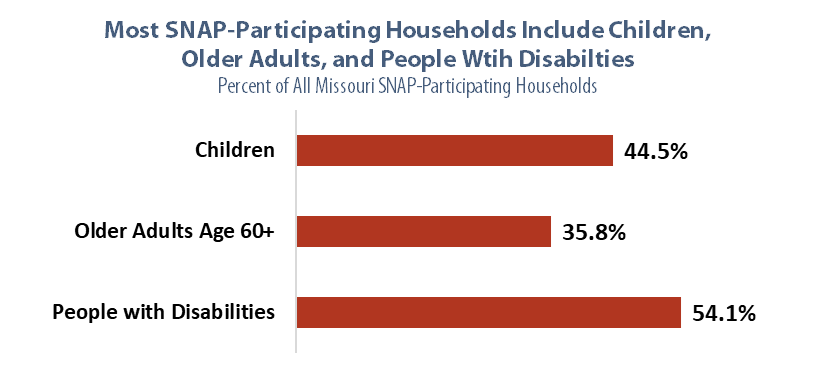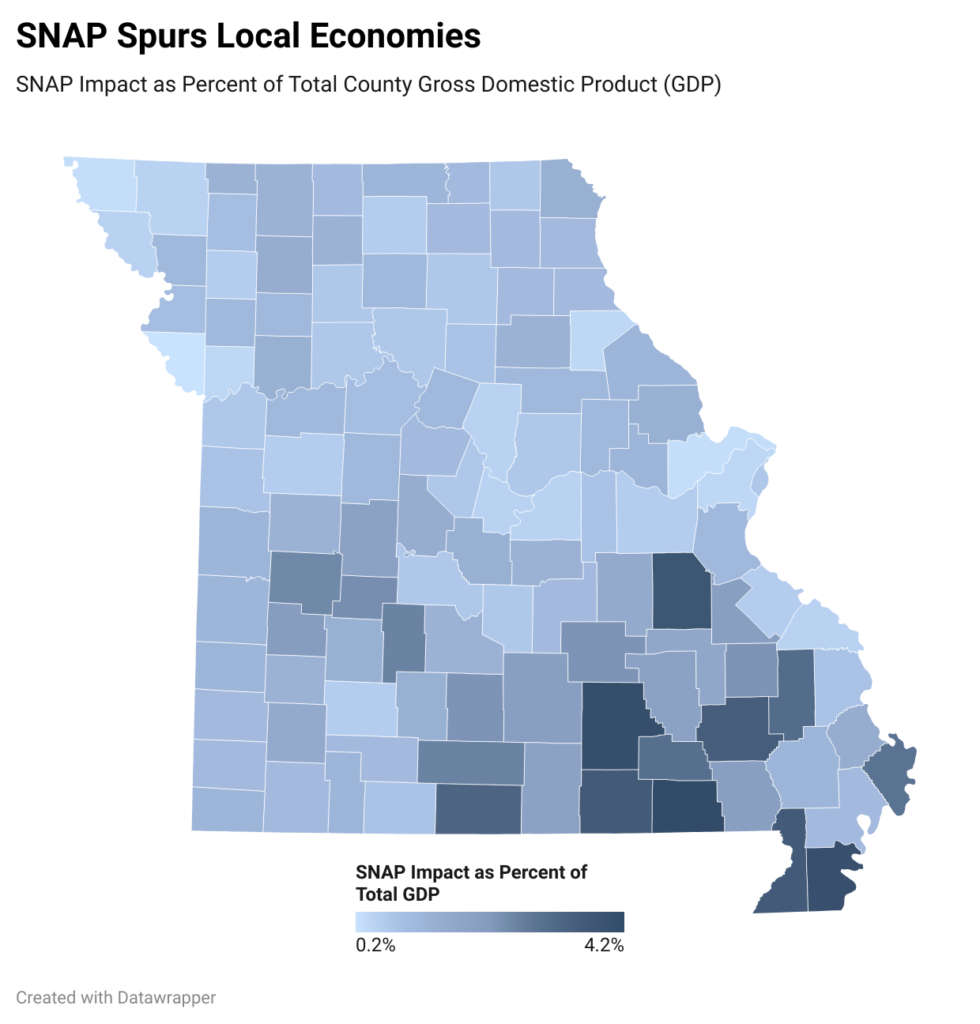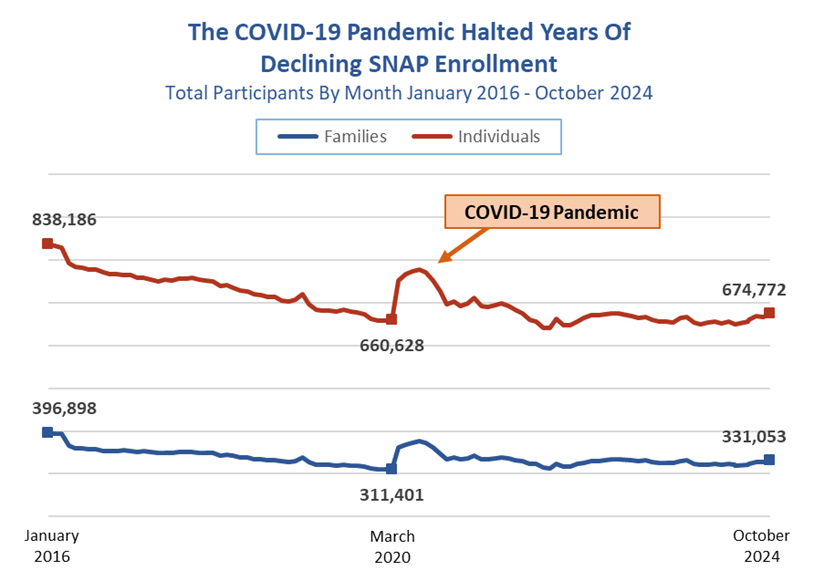Hunger Jeopardizes the Health & Well- Being of Missourians Throughout the State

- Food-insecure households cannot afford, or lack access to, quality nutritious foods that are essential to an active, healthy life.
- Food insecurity has been rising in Missouri since 2020 when household food insecurity reached a low of 11.5%. By 2023, 12.7%, or nearly 1 in every 8 households were food insecure.
- Children with food insecurity are more likely to have poor diets, cognitive and behavioral problems, anxiety, depression, and develop chronic illnesses such as asthma and anemia.
- Food insecurity among adults is linked to poor diet,
hypertension, diabetes, coronary heart disease, kidney disease, poor general and mental health, anemia, and depression. - Food insecure households often have to choose between paying for food or other basic necessities, such as utilities, transportation, housing, and medical expenses.
- Food insecurity is highly correlated with low income. Therefore, people of color are more likely than others to be food insecure. In 2022, approximately 31% of Black Missourians were food insecure, compared to 19% of Hispanic/Latine and 12% of non-Hispanic white Missourians.
The Supplemental Nutrition Assistance Program (SNAP) Plays a Vital Role in Reducing Food Insecurity

- The Supplemental Nutrition Assistance Program (SNAP), formerly known as food stamps, helps Missourians with low incomes purchase food, as well as plants and seeds to grow food.
- In fiscal year (FY) 2024, SNAP served an average of 655,264 Missourians in 323,462 households each month.
- The Missouri Department of Social Services (DSS) administers the program on behalf of the U.S. Department of Agriculture (USDA).
- The federal government funds 100 percent of the benefits SNAP recipients receive. The cost of administering the program is shared by the State and Federal governments.
SNAP Eligibility
To be eligible for SNAP, most households must meet three tests: gross monthly income (130 percent of the federal poverty line [FPL]), net monthly income (100 percent FPL), and asset limit (also known as resource limit). Households with elderly or disabled members do not have to meet the gross income test but must meet the net income test described below.
- Household earnings must be at or below the gross monthly income limits. Recognizing that households must spend much of their income on non-food necessities, they are then allowed to deduct certain expenses from their gross monthly income. The resulting net income must be at or below the net monthly income limits.
- A household’s total assets must be valued at $3,000 or less, excluding the primary home, vehicles, and certain other types of non-income producing assets. The asset limit is $4,500 for households that include members age 60 or older, or are disabled.
2024 Monthly Income Limits for SNAP Eligibility by Household Size
| Household Size | 1-person | 2-person | 3-person | 4-person |
| Gross Income (130% FPL) | $1,632 ($19,584) | $2,215 ($26,580) | $2,798 ($33,576) | $3,380 ($40,560) |
| Net Income (100% FPL) | $1,255 ($15,060) | $1,704 ($20,448) | $2,152 ($25,824) | $2,600 ($31,200) |
Additional Eligibility Requirements:
- All household members must have Social Security numbers.
- Felons who are in violation of probation or parole cannot receive benefits.
- Most able-bodied adults without dependents (ABAWDs) ages 18 – 54 are required to work or participate in a work program for at least 80 hours per month to receive SNAP benefits for more than three months in a three-year period.
- Able-bodied SNAP recipients ages 16 – 59, with or without dependents, can lose their benefits if they voluntarily quit a job working 30 hours or more per week, reduce their hours to less than 30 hours per week, or refuse a suitable offer of employment without good cause.
SNAP Benefit Amounts

- SNAP benefit amounts are based on household size, income, and certain expenses, such as housing, childcare, and medical expenditures. Each month, the household’s monthly benefit is deposited onto an electronic benefit transfer (EBT) card. The card can only be used at authorized food retail locations.
- SNAP participating households are expected to contribute 30 percent of their net income to food. If 30 percent of a household’s net income is less than the cost of the USDA Thrifty Food Plan (TFP), the household receives a benefit amount that makes up the difference between its contribution and the TFP cost for a household of its size.
- In Missouri FY 2024, the average monthly benefit was $397 per household, and $196 per person. Total benefits issued were $1,539,786,611.
Missourians From All Walks of Life Benefit from SNAP

- Nearly 7 of every 10 SNAP participants are children, older adults, and people with disabilities.
- Eight in every ten families participating in SNAP include at least one person who has worked in the past 12 months.
- An estimated 13.4% of rural households, 13.2% of small town households, and 9.2% metropolitan households participated in SNAP in 2021.
- SNAP helps an estimated 21,000 Missouri veterans put food on their tables.
- Among eligible SNAP participants, older adults are the least likely to participate in SNAP. For example, an estimated 172,000 older Missourians age 60 and over lived in poverty in 2023, but only about 85,000 older adults participated in SNAP each month.
SNAP Impact and Return on Investment (ROI)
SNAP Improves Nutrition & Health Outcomes

SNAP reduces food insecurity and financial hardship among children and households with low incomes. In some cases, food insecurity is reduced by as much as one third. And access to SNAP reduces the likelihood of credit account use and debt.

SNAP participation is associated with reduced hospital admissions and lower health care costs. A study of low income adults estimated SNAP participation reduced health care expenditures by $1400 annually per person.

SNAP participation during pregnancy is linked to a reduction in low birth weight babies. Children whose families participate in SNAP are also less likely to be underweight, have developmental delays, and be in poor health compared to children in families with low incomes who do not participate in SNAP. Furthermore, expanding SNAP eligibility is associated with reductions in reports of child maltreatment.

Children whose families receive SNAP do better in school, and are more likely to be economically self sufficient as adults, compared to low-income children who do not receive SNAP benefits.
SNAP Provides Critical Boost to Local Economies Throughout Missouri

- By increasing the purchasing power of families with low wages, SNAP creates a ripple effect on Missouri’s economy. Every SNAP dollar spent in local communities generates an estimated $1.57 in economic growth.
- The nearly $1.5 billion dollars in SNAP benefits that were redeemed in FY 2023 led to an additional $2.3 billion additional dollars flowing through local communities in Missouri.
- SNAP’s economic impact gives an especially critical boost to Missouri’s rural communities, accounting for over 4% of total Gross Domestic Product in some areas.
- SNAP is an efficient public–private partnership. Benefits are spent quickly and increase local demand for products and services, boosting job growth and the economy. Over 5,100 Missouri retailers (including grocery stores, superstores, and farmer’s markets) in every county in our state are supported by SNAP.
SNAP Is Critical Role to Meeting the Need of Workers and Families During Economic Challenges

- The need for safety net programs like SNAP generally increases during economic downturns. Participation rises when unemployment increases or wages fall.
- In this way, SNAP benefits act as an automatic economic stabilizer. By helping participants purchase food (and thereby supporting other household spending), it stimulates local economies.
- The recent pandemic illustrates how SNAP participation and spending can automatically expand when needed and contract as the economy strengthens.
- The COVID-19 pandemic forced over 200,000 Missourians out of work. From February to April 2020, the state unemployment rate more than tripled from 3.4% to 11.6%. During the same period, applications for SNAP jumped from 37,000 to nearly 70,000.
SNAP Facts
| Federal law mandates abled-bodied SNAP applicants ages 16 – 59 register for work and meet general work reporting requirements. | SNAP participants who do not comply with work reporting requirements, do not accept a suitable job offer, reduce their work hours to less than 30 hours a week, or quit their jobs without good cause can be disqualified from SNAP and lose their benefits. Furthermore, ABAWDs ages 18 – 54 who do not work or participate in a work program at least 80 hours a month cannot receive SNAP benefits for more than three months in a three year period. |
| Eight in every ten Missouri families participating in SNAP include at least one person who has worked in the past 12 months. | Many SNAP participants work in service and sales related jobs such as cooks, cashiers, home health aides. Cleaners, nursing assistants, and material packers are also among the many workers that participate in SNAP. SNAP participants’ jobs often provide low wages, unpredictable and fluctuating hours, and few benefits, such as paid leave. SNAP provides food assistance for workers and their families with low, volatile incomes. |
| Most SNAP participants who can work, do work. | A national study of working age SNAP participants found that nearly three quarters worked in the year before or after the month they received SNAP benefits. Most participants unable to work report having caregiving responsibilities, poor health, inability to find a job, or are attending school. |
| SNAP benefits can only be used to purchase food, and plants and seeds used to grow food. | SNAP benefits cannot be withdrawn as cash or used to purchase alcohol, tobacco, prepared foods, or non-food items such as medicine, soap, grooming items, paper products, or household supplies. |
| Unlawfully present immigrants are ineligible for SNAP. | Most lawfully present immigrant adults must live in the United States five years before they can become eligible for SNAP. Lawfully present immigrant children, refugees, and asylees are eligible for SNAP without a waiting period. |
| The charitable sector does not have the capacity to feed everyone in need. | Feeding America, the nation’s largest hunger-relief organization, reported $4.9 billion in donations and fundraising in 2023. This is less than five percent of the $107 billion in SNAP benefits the government distributed. |

